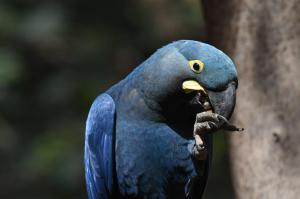
Loro Parque Fundación succeeds in saving 9 species of parrots from extinction
These species were critically endangered and, thanks to the Fundación's work, they have changed their endangered category, thus avoiding their disappearance
Yellow-eared Parrot, Colombia
Ognorhynchus icterotis
In 1998, there were only 82 Yellow-eared Parrots in Colombia. Over the years, thanks to the technical and financial support of the Loro Parque Fundación, with a contribution of more than $1,500,000 dollars, its population is currently around 4,000. Thus, its category has changed from 'critically endangered' to 'endangered'.
This bird is directly linked to a local palm tree from which the leaves were extracted for religious and cultural celebrations. And the link between the two species is so close that if the palm tree disappears, the Yellow-eared Parrot becomes extinct. Through the local organisation `ProAves', measures have been implemented that have enabled local people to become directly involved and protect their unique natural asset.
Lear’s Macaw, Brazil
Anodorhynchus leari
The Lear's Macaw, a native of north-eastern Brazil, has historically been the victim of hunting, looting, habitat destruction and pressures of various kinds in an area where conditions are extreme. In 1994, the census was less than 200 individuals, but today there are 1,300 individuals, moving them from the ‘critically endangered’ category up to ‘endangered’. Loro Parque Fundación has supported different actions for the recovery of this species with more than $460,000.
Blue-throated Macaw, Bolivia
Ara glaucogularis
Endemic to the vast plains of the Beni River, the Blue-throated Macaw, a true jewel of nature, did not exceed 50 specimens in the 1990s. Although still critically endangered, the populations that have been observed in the vast territory where they live now exceed 250 specimens. A large investment from 1995 to the present, of more than $1,500,000 dollars has made local populations aware of the danger to this species, which for years was exploited for the use of its feathers in traditional indigenous headdresses. The development of artificial feathers and workshops to learn how to make headdresses with the substitutes, has allowed thousands of macaws, of different species to benefit.
Red-tailed Cockatoo, The Philippines
Cacatua haematuropygia
The Red- Vented Cockatoo project in the Philippines is one of the star projects supported by the Loro Parque Fundación. Thanks to the important efforts of the local NGO `Katala Foundation', the various populations’ growth has been dizzying: from 22 in the 1990s to over 1,200 today, including the recent release to the wild of 7 specimens which were taken at an early age and later recovered from illegal trafficking. One of the most ingenious strategies developed has been to train prisoners in the local prison and former traffickers who plunder nests as 'guardians of the wild'. They are now guards in areas where they themselves previously poached and now recognise the importance of the decimation of the populations.
Red-tailed Amazon, Brazil
Amazona brasiliensis
The Brazilian Red-tailed Amazon Parrot is an endangered species of the Atlantic rainforest, mainly from the states of Sao Paulo and Paraná (with very few individuals in the north of the state of Santa Catarina), in the southeast of Brazil. For more than a decade, the Loro Parque Fundación has supported activities for the conservation of the wild population of this species, and the efforts made have proved a resounding success.
Consequently, the foundation has supported the environmental group 'Sociedade de Pesquisa em Vida Selvagem e Educação Ambiental' (SPVS) to monitor and protect its breeding areas, given that it is vital to involve the local population in order to preserve the trees on which the species depends, and it is encouraging to see how, in the short term, the use of artificial nests as an auxiliary system has given very good results and has had a direct impact on the increase in the numbers of the species.
Echo Parakeet, Mauritius
Psittacula eques
The Echo Parakeet is the last surviving native species of the genus that once inhabited all the western islands of the Indian Ocean. In 1986, a population of only 8 to 12 individuals was estimated with just three females. The recovery effort for this species was conducted through the 'Mauritius Wildlife Foundation' and as a result of these efforts, continued over time, the growth of the species on the island continues to be exponential, with a census that today exceeds 500 specimens.
Blue-headed Macaw, Peru
Primolius couloni
Peru, Brazil and Bolivia are home to the rare Blue-headed Macaw, although its localised populations are never very abundant. However, the global population is growing in numbers and its category of threat has also changed from 'endangered' to 'vulnerable'.
Horned Parakeet, New Caledonia
Eunymphicus cornutus
In New Caledonia, a parakeet with a head adorned with elegant feathers has suffered for years from invasive species in its habitat, such as rats, which attack its eggs and chicks. Monitoring their territories throughout the breeding season, and identifying breeding strategies and habitat conditions for the species, have allowed it to thrive in recent years, moving them from ‘endangered' to 'vulnerable'.
Black-cheeked lovebird, Zambia
Agapornis nigrigenis
Since 1997, the Loro Parque Fundación has collaborated with the Research Centre for African Parrot Conservation in South Africa researching into the populations of the Black-cheeked lovebird, a small parrot whose populations in south-western Zambia were little known. Learning about its habitat, its biology in general, and interacting with local populations so that they can understand the importance of preserving it and how to do so has been crucial for the recovery of this species that is now abundant in the environment.
Natalya Romashko
Communications Department, Loro Parque
34 922373841 Ext. 319
email us here
EIN Presswire does not exercise editorial control over third-party content provided, uploaded, published, or distributed by users of EIN Presswire. We are a distributor, not a publisher, of 3rd party content. Such content may contain the views, opinions, statements, offers, and other material of the respective users, suppliers, participants, or authors.




